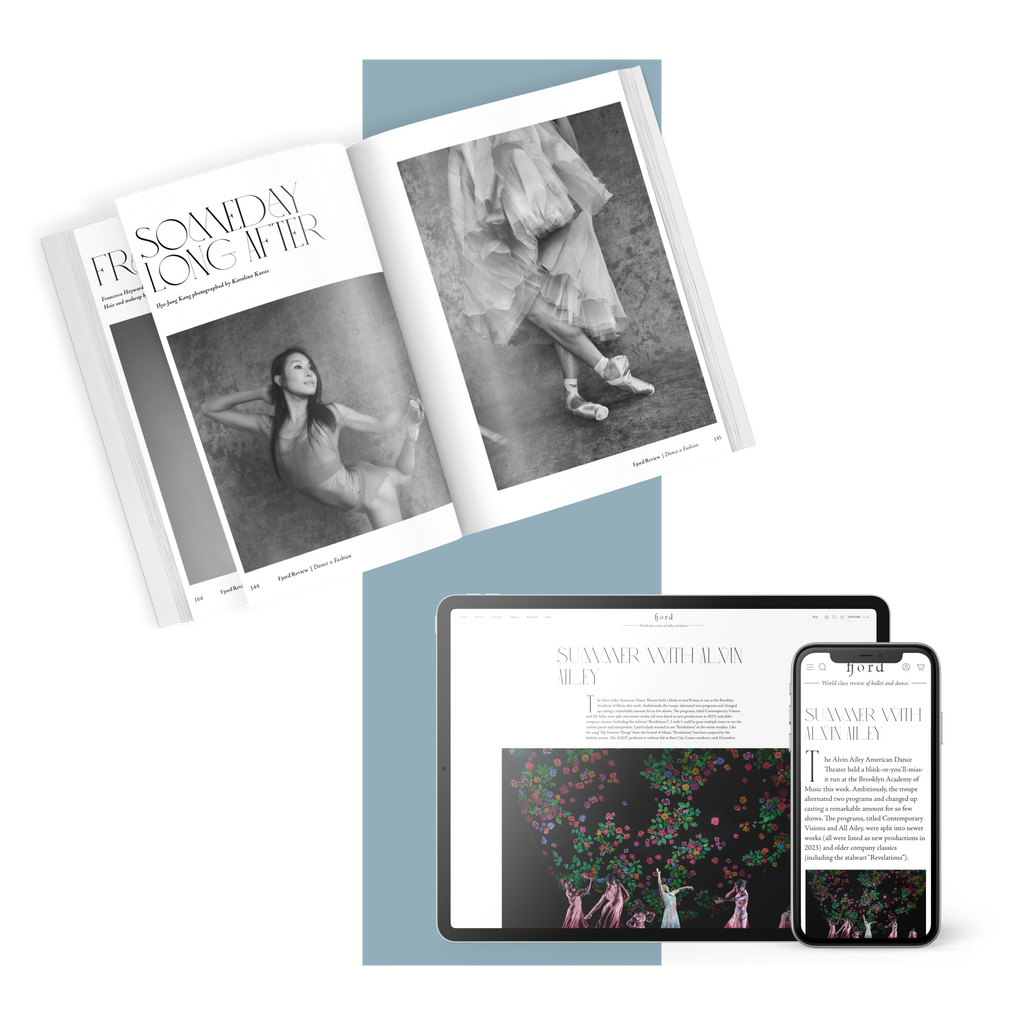This young, vibrant and enormously talented company (the troupe was founded 30 years ago by the legendary Edward Villella, a Balanchine disciple and tireless promoter of Balanchine’s principles and style) demonstrated impressive technique and effortless style, as well as exceptional vitality, uninhibited attitude and hunger for dance, taking New York City audiences by storm and capturing their hearts and imagination. The Magic City’s dancers delivered magic all their own, firmly establishing themselves as intelligent and assiduous interpreters of Balanchine’s choreography and as a world-class ballet troupe with an exciting, forward-looking repertory.
The first program opened with a classic of modernism and abstraction. “Symphony in Three Movements” is one of Balanchine’s so-called “black-and-white” ballets—a slick, athletic and jazzy choreographic response to the propulsive Stravinsky score of the same title. This is Balanchine at his most astringent and sophisticated. Created in 1972 to be performed as part of the NYCB Stravinsky Festival, the ballet was instantly recognized as a masterpiece and became a staple of the company’s repertory.
Watching the Miami dancers navigating through the Balanchine’s complex world of movement with confidence, exuberance and terrific youthful energy was an infinite joy. From the stunning diagonal of 16 white-clad ballerinas in ponytails who miraculously metamorphosed from eloquent beauties to fearless Amazons in the ballet’s opening section to the awe-inspiring ensemble that evoked complex perpetually-moving machinery in the ballet’s grand finale, the superb cast was marvelously assured, precise and inspiring. Radiant and resolute, this “Symphony” looked fresh and exhilarating, so beautifully alive and moving.
The petite and agile Nathalia Arja and Shimon Ito brought a special sense of playfulness and glee into their jumping contest in the first movement. Dancing with poetic lyricism and an appealing allure, the superb Patricia Delgado and Renan Cerdeiro imbued the central pas de deux with an air of eroticism, their liquid hands and wrists charting in space an exotic love poem. The entire cast simply dazzled in the finale, dancing with volcanic power and giving each movement equally heroic and terrifying edge.
The calm and spiritual “Sweet Fields”—a collection of 10 miniature dances by Twyla Tharp set to Shaker hymns and other choral music—brought an atmosphere of tranquility and repose into the theater. This utterly lyrical piece demonstrated just how versatile the Miami City Ballet dancers are and how comfortable and relaxed they feel and look in modern dance territory. Dressed in a flowing white attire, the ensemble held the audience in a perpetual trance, bringing to the fore the sheer loveliness and expansive freedom of the Tharpian vocabulary, with its communal spirit, earthy candor and heaven-inspired imagery.
Sweeping, poetic and emotionally rich, Alexei Ratmansky’s “Symphonic Dances” alludes, as do many of his other pieces, to the choreographer’s Russian heritage. Set to Rachmaninoff’s composition of the same name, the ballet was commissioned in 2012 by Villella, who at that time was the Miami City Ballet’s artistic director. It is a major work and a unique and valuable addition to the company’s contemporary repertory.
Masterly blending abstraction and narrative, in his “Dances” Ratmansky creates an endlessly absorbing theatrical world that is poignant, suspenseful and somewhat strange. Watching this piece, not for a moment you feel at rest. The choreographer perpetually keeps the audience guessing: What does this all mean? What is going to happen next? Your mind is restless; your senses overwhelmed. This “Dances” is a riot of abstract characters and incidental symbols; and when the curtain falls you are left with more questions than answers.
The opening themes mix the heroic and the tragic. It is up to the viewers to decide whether the leading man (the excellent Kleber Rebello) in a white shirt with a red starry mark on its back and his partner (Renato Penteado) are caring friends or grave rivals. Ratmansky’s logic aims to mystify and perplex and, as the dance progresses, there is a constant shift of connotations and meanings, and the mysteries keep on multiplying.
The second movement contains a gorgeous ballroom scene. As the music soars, the whirling couples look both splendidly dashing and ominously dangerous. Clad in translucent long overdresses of solid vibrant colors, the women float in their partners’ arms as if on air. Here, just as in the first movement, the dichotomy—the overriding presence of good and the evil—permeates the highly symbolic imagery onstage.
The closing section features yet another set of costumes and a new twist on the story (we believe there is a story here, which we are determined to decipher) as a young girl (Nathalia Arja) bursts onstage in an eruption of movement. She is surrounded by her supporters (or maybe it is the troupes), and her electrifying presence reverberates through the entire movement until at the conclusion she launches herself in the air and flies like an arrow into her partner’s arms.
Ratmansky’s “Dances” brims with emotional poignancy and multi-layered drama through and through; and the ambiguous and ever-shifting relationships among the soloists, as well as between the soloists and the corps de ballet leave plenty of room for interpretation. This is a piece that will definitely reward multiple viewings and never cease to reveal its many enigmas, with a wide range of characters suggesting personages that stepped out of the pages of Tolstoy, Dostoyevsky, Bulgakov, and Pasternak.




comments